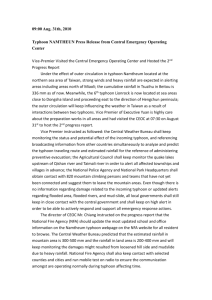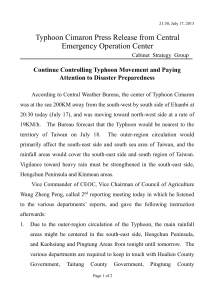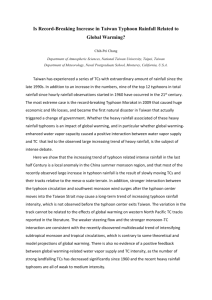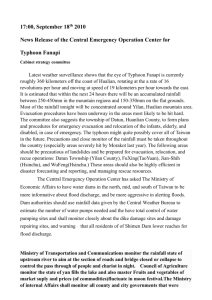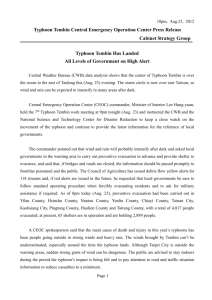Assessment of Heavy Rainfall Retrieved from Microwave Instrument in Taiwan... Chien-Ben Chou, Peter K.H. Wang
advertisement
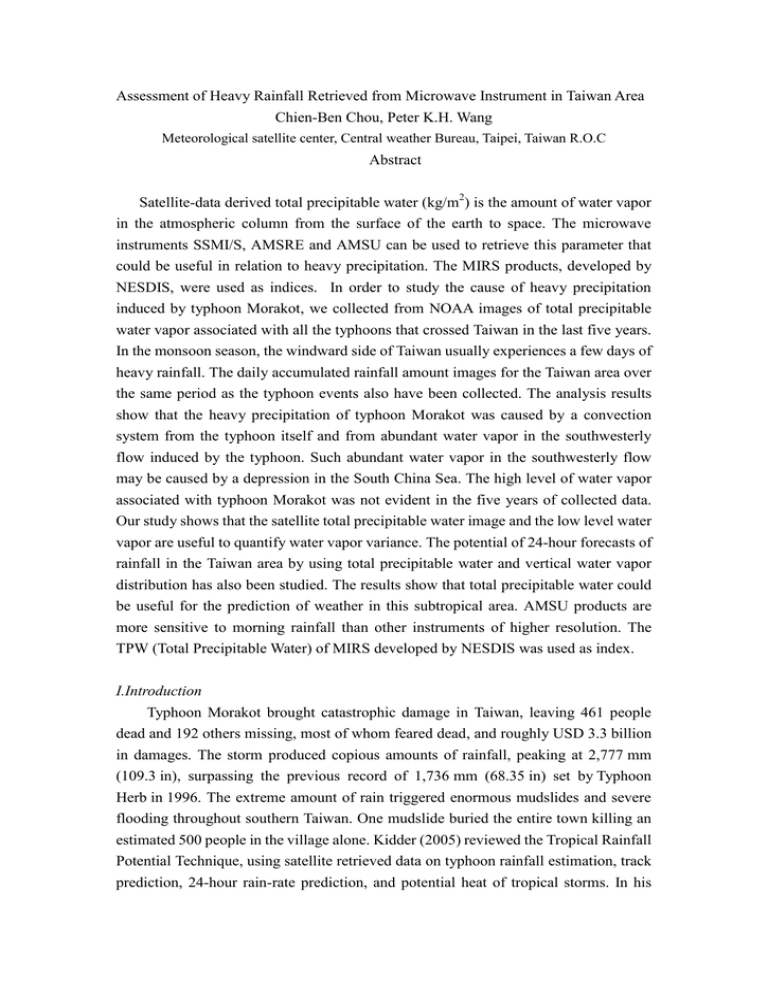
Assessment of Heavy Rainfall Retrieved from Microwave Instrument in Taiwan Area Chien-Ben Chou, Peter K.H. Wang Meteorological satellite center, Central weather Bureau, Taipei, Taiwan R.O.C Abstract Satellite-data derived total precipitable water (kg/m2) is the amount of water vapor in the atmospheric column from the surface of the earth to space. The microwave instruments SSMI/S, AMSRE and AMSU can be used to retrieve this parameter that could be useful in relation to heavy precipitation. The MIRS products, developed by NESDIS, were used as indices. In order to study the cause of heavy precipitation induced by typhoon Morakot, we collected from NOAA images of total precipitable water vapor associated with all the typhoons that crossed Taiwan in the last five years. In the monsoon season, the windward side of Taiwan usually experiences a few days of heavy rainfall. The daily accumulated rainfall amount images for the Taiwan area over the same period as the typhoon events also have been collected. The analysis results show that the heavy precipitation of typhoon Morakot was caused by a convection system from the typhoon itself and from abundant water vapor in the southwesterly flow induced by the typhoon. Such abundant water vapor in the southwesterly flow may be caused by a depression in the South China Sea. The high level of water vapor associated with typhoon Morakot was not evident in the five years of collected data. Our study shows that the satellite total precipitable water image and the low level water vapor are useful to quantify water vapor variance. The potential of 24-hour forecasts of rainfall in the Taiwan area by using total precipitable water and vertical water vapor distribution has also been studied. The results show that total precipitable water could be useful for the prediction of weather in this subtropical area. AMSU products are more sensitive to morning rainfall than other instruments of higher resolution. The TPW (Total Precipitable Water) of MIRS developed by NESDIS was used as index. I.Introduction Typhoon Morakot brought catastrophic damage in Taiwan, leaving 461 people dead and 192 others missing, most of whom feared dead, and roughly USD 3.3 billion in damages. The storm produced copious amounts of rainfall, peaking at 2,777 mm (109.3 in), surpassing the previous record of 1,736 mm (68.35 in) set by Typhoon Herb in 1996. The extreme amount of rain triggered enormous mudslides and severe flooding throughout southern Taiwan. One mudslide buried the entire town killing an estimated 500 people in the village alone. Kidder (2005) reviewed the Tropical Rainfall Potential Technique, using satellite retrieved data on typhoon rainfall estimation, track prediction, 24-hour rain-rate prediction, and potential heat of tropical storms. In his paper he indicated the limitation of 24-hour rain-rate prediction for typhoons. One reason is inadequate observational data over oceans, another reason is Numerical Weather Prediction models cannot deliver precise rain-rate predictions, even if the model has sufficient, precise initial. Radar observed data could be applied for short-range (about 1 hour) rain-rate predictions and flooding forecasts, but cannot help until a typhoon enters the radar observation range. Typically typhoons are located over the sea so that radar data is useful only when a typhoon comes close to Taiwan’s shore. Therefore, using radar data for 24-hour rainfall forecasts has some limitations. 24-hour rain-rate prediction of typhoons is very critical information for natural disaster prevention since any evacuation policy needs sufficient time for decision making as well as execution. Satellite observations cover huge areas, including ocean, and microwave instruments, especially, have the capability to observe hydrologic information within cloud areas. Infrared remote sensing sensors, despite their valuable multi-frequency characteristics, have limited utility due to the lack of cloud penetration. IR (Infrared) data could be used to retrieve some cloud parameters, such as cloud top height, cloud top temperature and phase of cloud but data can observe only exterior features of clouds. American Defense Meteorological Satellite Program (DMSP) launched its first satellite in 1987, which carried Special Sensor Microwave Imager (SSM/I) on board. SSM/I provides more cloud retrieved parameters, including cloud liquid water content, rain-rate and total precipitable water (TPW), both of which correlate with rainfall amount. National Oceanic and Atmospheric Administration (NOAA) satellite series have had the Advanced Microwave Sounding Unit (AMSU) on board since NOAA-15 in 1989. Water vapor relevant products could also be derived from AMSU. Weng (2003) used microwave satellite data retrieved liquid water content and total precipitable water within clouds. Kidder (2007) described how total precipitable water could be a useful information source for heavy rain-rate forecasts. Consequently we chose TPW as a reference index in our analysis of Typhoon Morakot’s features. Total precipitable water, IR satellite images, surface rain gauge and weather charts are used to analyze the cause of heavy rainfall from Typhoon Morakot and to try to investigate the capability of a 24-hour rainfall prediction from TPW for the Taiwan region. II. Cases study Typhoon Morakot was formed early on August 2, 2009 to the northeast of the Philippines. Early on August 7, the storm attained its peak intensity with winds of 150 km/h, the equivalent of a Category 2 hurricane. Morakot weakened slightly before making landfall in Taiwan later that day. It passed out to sea on August 8 at 2 PM. Roughly 24 hours later, the storm came back over the sea into the Taiwan Strait and weakened to a severe tropical storm before making landfall in China on August 9 at 6:30 PM. The storm gradually weakened as it continued to slowly track inland. The last remnants of the typhoon eventually dissipated on August 11. From the surface weather chart of Aug. 6, 2009, as shown in Figure 1, on Aug. 6 at 00UTC a low-pressure center was located over the east sea of Taiwan (Fig. 1a). There was a tropical depression close to Hainan Island, China (Fig. 1b) on Aug. 7 at 00UTC, and on Aug. 8 at 00UTC (Fig. 1c) Typhoon Morakot had intensified and moved closer to Taiwan and closer to the tropical depression of Hainan Island and the circulation of this depression merged with the typhoon. In the meantime the southwesterly flow was clearly observed around Hainan Island. Typhoon Morakot was moving to northwest on Aug. 9 and 10 (Figs. 1d and 1e). The two depressions, now merged, could be found on the surface weather chart and in IR satellite images. Fig. 2a-e are a sequence of images showing these 2 storms and the boundary separating them gradually dissipating. In terms of reviewing TPW variation from satellite imagery to explain the cause of heavy rainfall, for sun synchronous satellites, NOAA satellites pass over the region at about 1 PM local time (05UTC) and 1 AM local time (17UTC), so surface rain gauge data for midnight to 2 PM and midnight to 8 PM were used for the accumulated rainfall. Figures 3-8 show the comparison of these satellite and ground observations over the time period August 6-9. In figure 3 (Aug. 6) higher TPW was extended over a huge area of the sea to the east Taiwan with a maximum TPW of over 70kg/m². On Aug. 6, for midnight to 2PM, the accumulated rainfall in Taiwan for these 14 hours was just 20mm. Data for Aug. 7 is shown in figures 4 and 5 when Typhoon Morakot was very close to Taiwan. The progression of the typhoon is shown in the track map if figure 9. It was found that when the highest levels of TPW covered the whole of Taiwan, the accumulated rainfall in both the north and south of Taiwan were over 300mm, this caused by the strongly convective cloud of the typhoon. After typhoon landed in Taiwan on Aug. 7 (Figs. 6 and 7), there was a high TPW rain band extended from Hainan Island area to the sea south Taiwan, and the accumulated rainfall in southern mountain area of Taiwan was up to 1200mm. Heavy rainfall continued here until Aug. 9, as shown in figure 8. From figures 3, 4 and 5, it is found that Hainan Island area TPW was increasing from the tropical depression consistently since Aug.6. No data was available to show this tendency in figures 4 and 5, due to gaps in the satellite coverage at these times for this area, but some higher TPW could be found in the edges of satellite images. The area’s existing high TPW merged into the typhoon’s path may have induced a much higher precipitable water amount, this compounded further by the location windward of Taiwan’s southern mountains. In IR images were found some depression clouds near southeast of Typhoon Morakot where high TPW was distributed. This means that atmospheric conditions were here quite unstable. A temperature anomaly was found at 300 hPa on Aug. 8 when the strength of the typhoon peaked, as shown in figure 10. Figure 11 shows a collage of satellite TPW imagery for typhoons passing over Taiwan in the five-year period from 2005 to 2009. The value and distribution size of TPW of Typhoon Morakot is the highest among these. Other images have similar features as Morakot, but did not deliver such a devastating amount of rainfall. After the circulatory typhoon winds, abundant TPW is perhaps the next most important factor when considering typhoon impacts. 24-hour rainfall prediction is very important information in natural disaster warning and prevention. TPW and other relevant information to predict more precise rainfall amounts would be helpful and valuable information. For the routine work of weather services, the tracking bias of a typhoon is about 50Km. Goerss (2009) showed that satellite data, such as Geostationary satellite derived wind vectors, TPW derived from SSMI/S and radiances of Advanced Microwave Unit-A (AMSU-A), have positive impact on typhoon track prediction skill. Orbital satellite pass has some gaps between passes when pass over tropical area causes the data missing in some critical area. More frequently satellite project or Geostationary based microwave instrument should be anticipated in next a few years. III. Conclusion A tropical depression that develops over the ocean will likely not have much surface data to assist in disaster forecasting. TPW, however, is derived from satellite data and has a direct relationship with precipitation. After the above analysis it is found that, with respect to typhoons with and accompanying southwesterly flow, TPW is a very useful parameter for rainfall prediction. Not only TPW but also typhoon category, translation rate of typhoon, and terrain all affect the rainfall amount delivered by a typhoon. In this research, using satellite derived TPW, IR satellite images and weather charts, we have assessed the factors that contribute to the heavy rainfall from Typhoon Morakot. This information should be useful information for 24-hour rainfall prediction. For Typhoon Morakot passing over Taiwan in 2009 from August 7-10, an historical high precipitation record was set (over 3000mm), flooding and landslides were experienced, and heavy rainfall was located around the outside of the tropical storm wind speed circle. It is found that the area of high TPW (>90mm) for POES over ocean has a close relationship with rainfall over island, but with a 12 hour delay. Same situation on SSM/IS F16 maximum TPW shows a close relationship with rainfall almost without delay for its narrow swath. For winter monsoon precipitation: Exclude cold front influence, area amount of TPW (>45mm) is relative to max TPW and has a little relation to rainfall. For SSM/IS F16, TPW(>45mm) area amount has close relationship with maximum TPW, same as for POES, a little relationship with rainfall over land and has about a 12 hour delay. TPW used over land is limited due to surface emissivity uncertainties. TPW amount over 90mm in regional area and maximum TPW value over ocean could be a useful rainfall indicator before typhoon landing. TPW is a nice index for disaster rescue. Continue and steady precipitation weather has similar tendency as in typhoon for TPW maximum and TPW amount (>45mm). There are wind field and geographic issues that may affect rainfall distribution in Taiwan island, it is shown the total amount of rainfall somehow has a close relationship with microwave radiometer derived TPW. Future work includes: 1) Involve other microwave instruments, which may decrease the observation gaps especially over tropical area. 2) Estimation bias of TPW exists (as for other parameters); reduce the bias error and find out more realistic relationship between TWP and rain rate is necessary. 3) Typhoon track is very important to rainfall prediction, how to improve satellite data initialized in NWP model is another important issue for typhoon track prediction. Acknowledgments: The authors wish to thank Fuzhong, Christopher and MIRS team in STAR/NESDIS/NOAA for providing MIRS technical supports and satellite data. IV. Reference Kidder, S. Q., and Coauthers, 2005: The tropical rainfall potential (TRaP) technique. Part I: Description and Examples. Wea. Forecasting, 20,456-464 Kidder, S. Q., and A. S. Jones, 2007: A blended satellite total percipitable water product for operational forecasting. J. A tmos. and Oceanic Technol., 24,74-81 Rappaport, E.N., 2000: Loss of life in the United States associated with recent Atlantic tropical cyclones. Bull. Amer. Meteor. Soc., 81, 2065-2073 Goerss, J. S., 2009: Impact of satellite observations on the tropical cyclone track forecasts of the navy operational global atmospheric prediction system. Mon. Wea . Rew.,137, 41-50 Weng, F., L. Zhao, G. Poe, R. Ferraro, X. Li, and N. Grody, 2003: AMSU cloud precipitation algorithms. Radio Sci., 38, 8068-8079 a b c d Figure1. Each day’s 00UTC surface weather chart, from Aug. 6 to Aug. 10. e Figure.2 Each day’s 00UTC IR images, from Aug. 6 to Aug.10. Figure 3. TWP image for Aug. 6, 04UTC, 14 hours rainfall until. Aug.6 06UTC Figure 4. TWP image for Aug. 7, 04UTC, 14 hours rainfall until. Aug.7 06UTC Figure 5. TWP image for Aug. 7, 15UTC, 20 hours rainfall until. Aug.7 12UTC Figure 6 TWP image for Aug. 8, 04UTC, 14 hours rainfall until. Aug.8 06UTC Figure 7 TWP image for Aug. 8, 15UTC, 20 hours rainfall until Aug.8 12UTC. Figure 8 TWP image for Aug. 9, 12UTC, 14 hours rainfall until Aug.9 06UTC. Figure 9 Typhoon track of Morakot. Time is UTC. Figure 10. Temperature anomaly on 300mb on Aug. 8. 2009, estimated from MIRS Figure 11. Comparison between TPW images for typhoon passed over Taiwan area from 2005 to 2009。 Figure12-a TPW derived from AMSUA has evident relationship with 3 hours later rainfall on whole island and south Taiwan Figure 12-c Time series of TPW shows Close rainfall for winter monsoon has steady rain-rate. Figure12-b TPW from SSM/IS F16 has little time delay between TPW and rainfall Figure 12-d Time series of TPW of SSM/IS F16 shows no relation between TPW and rainfall since F16 has more narrow swath than POES, it means coverage of F16 does not respond to the rainfall area.

